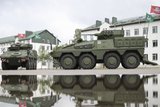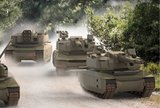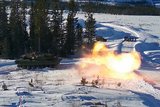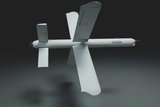Lockheed Martin's JLTV resists mines at lower weight
Recent government blast tests demonstrated that Lockheed Martin's Joint Light Tactical Vehicle (JLTV) meets protection standards for IED-protected vehicles, while weighing approximately 40 percent less than other all-terrain models deployed in theater.
Lockheed Martin's JLTV succeeded in its blast tests, which used explosions commonly tested against many existing mine-resistant fleet vehicles.
"Our improved v-hull design is demonstrating its merit, having now surpassed Technology Development protection targets set by our customer," said Scott Greene, vice president of ground vehicles in Lockheed Martin's Missiles and Fire Control business. "Our team has produced a remarkable family of vehicles that strikes the right balance between weight and force protection."
The results verified Lockheed Martin's JLTV can protect soldiers from powerful blasts and still be transported by vertical lift, a new mobility option for the Army and Marines at this protection level. Previous US Army and Marine Corps tests showed JLTV can be transported by CH-47 and CH-53 helicopters.
"In addition to being helo-transportable and mine-resistant, our JLTV design also brings another important advantage to the battlefield: improved mobility. Its lightweight, agile design will help soldiers to evade enemies and avoid threats," Greene said.
The government results mirrored Lockheed Martin's company-funded blast tests on its improved vehicle design. The Engineering and Manufacturing Development (EMD) vehicles feature evolutions in cab size and more affordable component materials.
Separate from those above-threshold tests, Lockheed Martin conducted over 20 blast and 200 ballistic component tests before Technology Development started.
"We anticipated blast protection requirements would increase for the EMD phase of the JLTV program, and we designed for it," said Kathryn Hasse, JLTV program director in Lockheed Martin's Missiles and Fire Control business. "We are acutely focused on providing enhanced force protection, performance and payload in an affordable vehicle system."
Lockheed Martin is pursuing the JLTV program, a joint services effort to return advanced mobility, protection and payload to deployed troops by replacing and complementing the aging High Mobility Multipurpose Wheeled Vehicle (Humvee) fleet. The JLTV program creates a common family of vehicles consisting of the Combat Tactical Vehicle and Combat Support Vehicle, both with multiple variants and associated companion trailers.
Source: Lockheed Martin
More from Land Warfare
-
![Hungary set to begin using Hero 400 loitering munitions]()
Hungary set to begin using Hero 400 loitering munitions
Developed by Israel's Uvision and with systems being sold in the thousands to multiple European NATO countries and the US, the Hero family of loitering systems is also in production in the US and Italy, the latter through Rheinmetall.
-
![Croatia orders Leopards and CAESAR howitzers as Lithuania orders more CAESARs]()
Croatia orders Leopards and CAESAR howitzers as Lithuania orders more CAESARs
The Leopard is becoming the tank of choice in central and eastern Europe as Croatia joins Lithuania, the Czech Republic and Hungary in ordering the platform. Lithuania and Croatia have also signed for CAESAR howitzers.
-
![Light Reconnaissance Strike – enabling a vital mission set (Studio)]()
Light Reconnaissance Strike – enabling a vital mission set (Studio)
A new system-of-systems concept will unlock digital integration of sensors and weapons for Light Forces, allowing them to shape the battlefield environment on their own terms and upgrade legacy platforms.
























